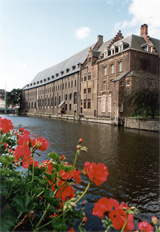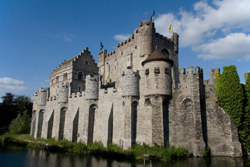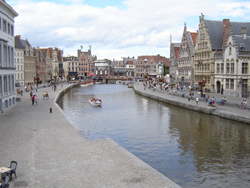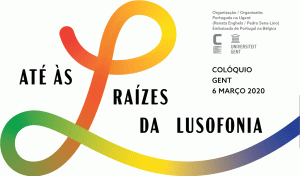I Colóquio Internacional – Português na UGent
É possível mapear e identificar as raízes do que chamamos “lusofonia”? Será que estas raízes incluem não apenas a herança greco-latina, por via europeia, mas também (rizomas) judaicos, visigóticos, islâmicos, indígenas, africanos, asiáticos? Como se manifestam hoje na lusofonia, e de que forma? Como podemos encontrá-las nas Ciências Humanas, sobretudo na Linguística e Literatura? Que estratégias de assimilação, dissimilação e sobreposição destas diversas origens podem ser identificadas, e o que significam?
A partir da Linguística e da Literatura, abrindo o leque de análise à História e aos estudos culturais, este colóquio lusófono organizado pela Universidade de Gent com o apoio do Instituto Camões pretende desenterrar questões e abrir novas dinâmicas de interpretação, contribuindo para uma visão mais alargada do que consideramos ser a Lusofonia, procurando ir mais além de categorias impostas pelo passado colonial.
Inscrições obrigatórias para: pedro.senalino@ugent.be
Organização: Português na UGent
- Pedro Sena-Lino
- Renata Enghels
- Eimbaxada de Portugal na Bélgica
- Instituto Camões
PROGRAMA
9h15 – Abertura dos trabalhos
9h30 – Conferência de Abertura: “Raízes da Lusofonia: o pluricentrismo da língua portuguesa”
Augusto Soares da Silva (Universidade Católica Portuguesa)
10h30-11h00 – Pausa para café
11h-12h30: Primeira sessão plenária: Linguística
Moderação: Professora Doutora Renata Enghels (Universiteit Gent)
- 11h – 11h30 – Políticas Linguísticas e Mecanismos de Manutenção do PLE e suas culturas: a bilateralidade Portugal/ Brasil na difusão do PLA/ PLE
Alexandre Ferreira Martins (Université Poitiers, France)/ Maria Micaela Ramon (Universidade do Minho, Portugal) / Mariana Killner (Universidade do Minho, Portugal)- 11h30 – 12h00 – A cooficialização de línguas em municípios brasileiros: uma ameaça à lusofonia?
Fernanda Castelano Rodrigues (Universidade Federal de São Carlos – Brasil)/ Flávia B. M. Hirata-Vale (Universidade Federal de São Carlos – Brasil)- 12h00 – 12h30 –Vidas em trânsito: a narrativa de Dois irmãos sob perspectiva semiótica
Cinthia Paes Virginio (Universidade Federal Fluminense, Rio de Janeiro – Brasil)
12h30-13h30: almoço (a cargo da organização)
Moderação: Pedro Sena-Lino/ alunos de Português da UGent
13h30-14h15: Dois escritores refletem sobre a Lusofonia: leitura e entrevista
- Ana Pessoa (literatura infanto-juvenil)
- Francisco Ribeiro Rosa (romance)
14h15 – 16h15: Segunda sessão plenária: Literatura e História
Moderação: Doutor Pedro Sena-Lino (Universiteit Gent)
- 14h15 – 14h45 – As raízes insulares da singularidade de João Vário
Maria Sofia da Silva Santos (Universidade de Cabo Verde – Mindelo)- 14h45 – 15h15 – Reconstrução de uma identidade estilhaçada: Um defeito de cor de Ana Maria Gonçalves
Leonor Lourenço de Abreu (UCLouvain-la-Neuve)- 15h15 – 15h45 -Escrituras aquáticas e raízes lusófonas: o que dizer de seus frutos?
Wilson Alves Bezerra (UFSCar – Brasil)
15h45 – 16h15 –Pausa para café
Moderação: Doutor Nettah Yoeli Rimmer (Universiteit Gent)
- 16h15 – 16h45- Editorship and Modernity. The Portuguese Periodical Sociedade Futura (Lisbon, 1902-1904).
Christina Bezari (Ugent)- 16h45 – 17h15 – O ministro panfletário: o Marquês de Pombal revisor e propagandista. Uma análise a partir de manuscritos inéditos da colecção Pombalina.
Pedro Sena-Lino (Ugent)
17h15 – 18h15 – Conferência de Encerramento: Raízes coloniais e pós-coloniais da Lusofonia
Ana Paula Ferreira (University of Minneapolis, EUA)
18h30-20h – Jantar volante (reservado aos conferencistas e organização)
VENUE
 The conference will be held at “Het Pand”, the Cultural Centre of Ghent University. “Het Pand”, a former Dominican monastery, is located in the historical centre of the city, on the banks of the river “Leie”. The oldest parts of this impressive building date from the 13th century. During five centuries it was extended and refashioned in different styles. Since its rehabilitation and restoration, finished in 1991, “Het Pand” has been offering a wide range of possibilities for the organisation of scientific congresses and cultural events. “Het Pand” houses some valuable collections, such as the rich ethnographical and archaeological collections of the university, the Museum for the History of Medicine, full-size photographs of paintings of Brueghel and Early Flemish Masters, and an interesting collection of stained glass.
The conference will be held at “Het Pand”, the Cultural Centre of Ghent University. “Het Pand”, a former Dominican monastery, is located in the historical centre of the city, on the banks of the river “Leie”. The oldest parts of this impressive building date from the 13th century. During five centuries it was extended and refashioned in different styles. Since its rehabilitation and restoration, finished in 1991, “Het Pand” has been offering a wide range of possibilities for the organisation of scientific congresses and cultural events. “Het Pand” houses some valuable collections, such as the rich ethnographical and archaeological collections of the university, the Museum for the History of Medicine, full-size photographs of paintings of Brueghel and Early Flemish Masters, and an interesting collection of stained glass.
A small map with the location of ‘Het Pand’ can be found here.
The City of Ghent
 Ghent or Gent (in Dutch), lies in the heart of Flanders, between Bruges, Antwerp and Brussels. Its rich heritage has shaped the city into a living museum with a “medieval skyline”. It is by no means a coincidence that Ghent is often referred to as the historic heart of Flanders, a city of all times, and as one of the most beautiful historic cities in Europe. The city is after all a combination of an imposing past with a lively present. Not only the lovers of art and culture make their tricks in Ghent: also if you like to go shopping for a day, enjoy a good meal or have an entertaining night out, Ghent offers everything you require.
Ghent or Gent (in Dutch), lies in the heart of Flanders, between Bruges, Antwerp and Brussels. Its rich heritage has shaped the city into a living museum with a “medieval skyline”. It is by no means a coincidence that Ghent is often referred to as the historic heart of Flanders, a city of all times, and as one of the most beautiful historic cities in Europe. The city is after all a combination of an imposing past with a lively present. Not only the lovers of art and culture make their tricks in Ghent: also if you like to go shopping for a day, enjoy a good meal or have an entertaining night out, Ghent offers everything you require.
Ghent is an often neglected jewel when it comes to visiting Flanders, the Flemish speaking region of Belgium. Most visitors focus on Antwerp, Bruges or Brussels. But in doing so, they miss the opportunity to discover a city with a strong historical background that goes back to the Middle Ages. The city has been on the cross road of many political and economical shifts in the Western European context. Spanish, Austrian, German, Dutch, French, English,… have influenced the Ghent history and left behind traces, thus enriching a cultural heritage that reflects a unique blend of styles, traditions, architecture, and culinary trends.
 The city prospered due to the textile trade, and was one of the largest cities in Western Europe. Visiting kings envied the cultural patrimony and had to cope with the stubborn nature of citizens that strongly defended their autonomy. The city has evolved from a variety of settlements on the banks of the River “de Leie” and “de Schelde”.
The city prospered due to the textile trade, and was one of the largest cities in Western Europe. Visiting kings envied the cultural patrimony and had to cope with the stubborn nature of citizens that strongly defended their autonomy. The city has evolved from a variety of settlements on the banks of the River “de Leie” and “de Schelde”.
The city nearly equals Bruges when it comes to the number of museums, canals and bars. It offers a larger variety when it comes to contemporary art, theatres, and concert halls. Your list of “things to see” should include the medieval Gravensteen Castle, the belfry, the cathedral with the famous painting of the brothers Van Eyck “The Adoration of the Mystic Lamb”, the St. Nicolas Church, the three beguinages, monasteries, etc.
Nowadays Ghent is an economical centre due to its renowned international port and a cultural centre due to the large concentration of educational institutes, varying from the Ghent University, the largest concentration in Flanders of higher professional education institutes, to secondary and primary schools.
TRAVEL
A description of how to get to Ghent from Brussels National Airport can be found here.
Accommodation
Here is a list of good hotels in Gent, but of course, there are many more options for accommodation in the historical center of Ghent, at a walking distance from the conference location.
Hotels
Novotel Ghent Centre (110-130€/night)
NH Hotel Belfort (110-130€/night)
Hotel Gravensteen (80-130€/night)
Best Western Chamade (95-140€/night)
Ibis Gent Centrum Opera (80-130€/night)
B&B’s
http://www.gent-accommodations.be/
http://www.bedandbreakfast.be/bed_and_breakfast/in/Belgium/Oost-Vlaanderen/Gent/
http://www.charmio.com/en/region/ghent
